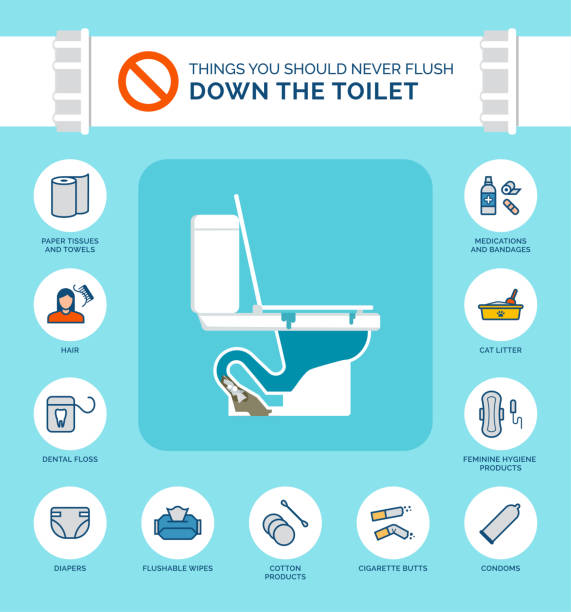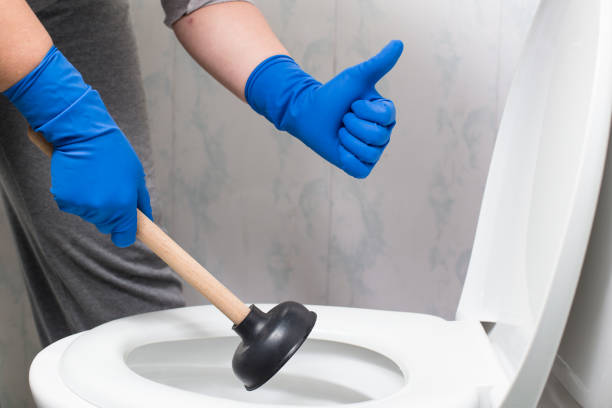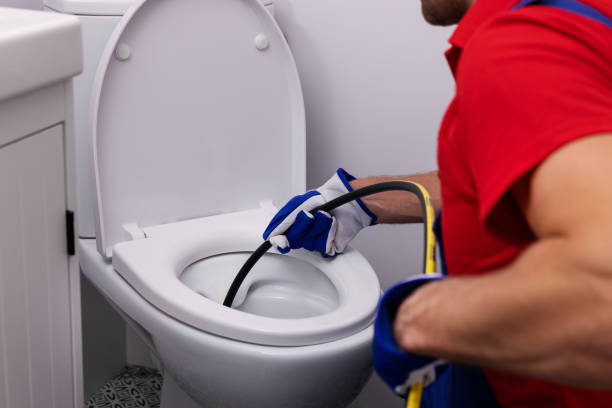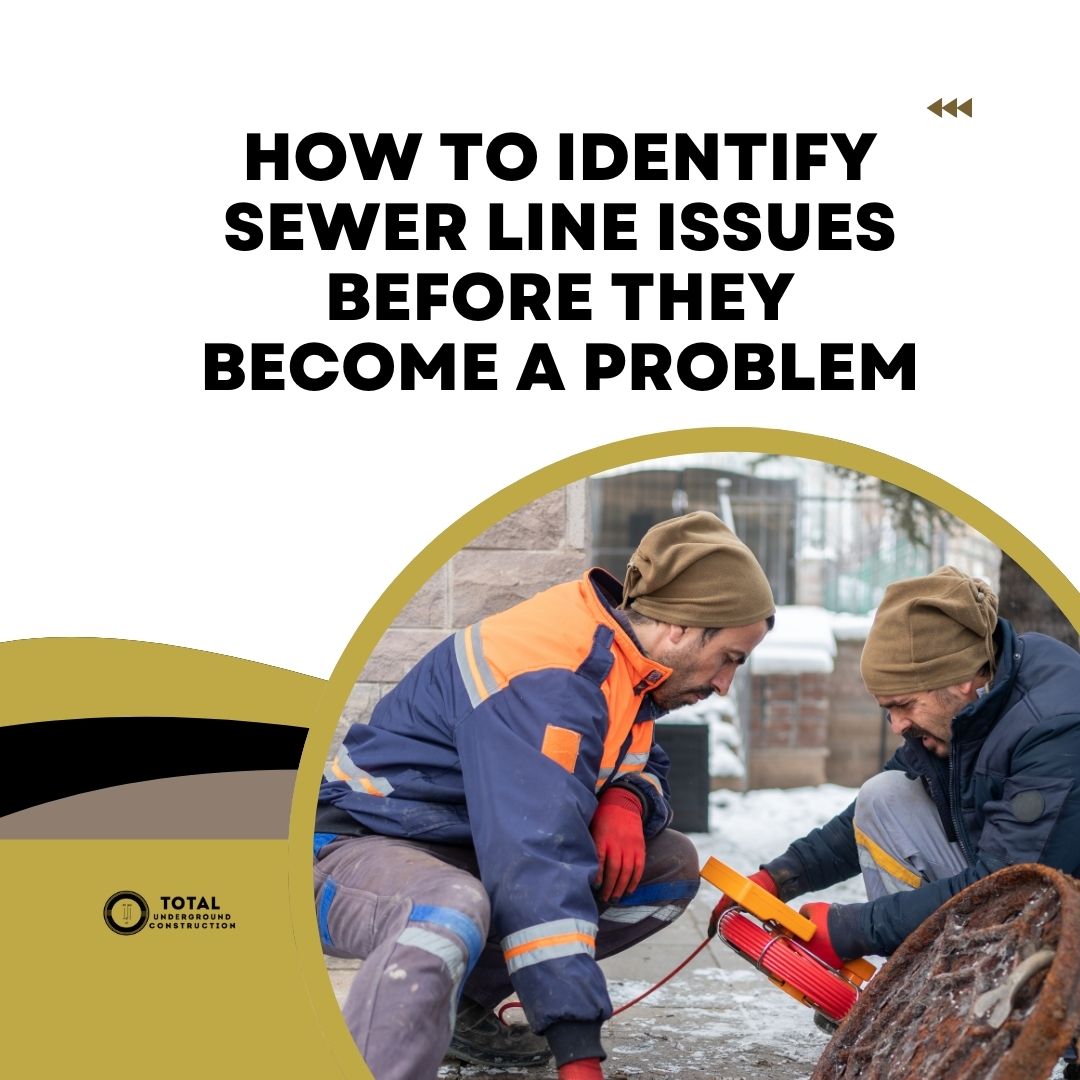Blockages are one of the most common toilet problems. But instead of dreading the day your loo clogs up and threatens to spew its contents onto your bathroom floor, get clued up on how to unclog a toilet.
If the thought of potty water damaging your floors and furniture and spreading germs around your home makes your stress levels soar, know there are plenty of DIY methods to get things flowing the right way again.
We asked our Total Underground Construction plumbing experts for their top 10 DIY toilet unclogging tips. Our team has seen and tried it all, so they have lots of advice to share.
Here’s the DIYer’s ultimate guide to clearing toilet clogs.
Understanding the Mechanics of a Toilet

Perhaps your understanding of how a loo works doesn’t go beyond “push down the handle to flush,” and you’ve never been tempted to peer into the tank (the back part that holds the flushing water). In this case, you’ll need a quick lesson on how toilets work before you can successfully tackle one that’s clogged.
Here’s what should happen inside the tank when you flush a standard gravity-flush design (found in most homes):
- A lever with a chain attached lifts a valve, releasing the tankful of water into the bowl (the part you sit on).
- The water rushes in so forcefully that it pushes the bowl’s wastes into a curved pipe at the back of the bowl (called a trap) and out of sight.
- The wastes then travel into the house drain system and municipal sewer lines.
- As the tank’s water level falls, a valve to the water supply automatically opens to let more water into the tank and then closes once it’s full.
While this basic design has worked swiftly and smoothly for hundreds of years, it’s not fail-safe. These are the 4 most common reasons things go wrong, and toilets get clogged:
1. There’s too much toilet paper. Filling the bowl with paper before flushing is a recipe for a blockage.
2. There’s a non-flushable item blocking a pipe. Anything other than digestive waste and toilet paper can clog a toilet.
3. There’s not enough water to flush away the waste. Some water-saving toilets lack the power to push waste and toilet paper through the trap and into the drain system.
4. Something is blocking a pipe from the outside (for example, tree roots.)
Essential Tools to Unclog a Toilet
Get your hands on these DIY unclogging must-haves:
- Plunger
- Toilet auger
- Enzyme waste-removal product
- Protective gloves and glasses
We’ll get into the what and how of these tools in our tips below.
Put on those gloves (don’t attempt any of the methods below with bare hands) and let our pro plumbers guide you in the best ways to unclog your toilet. Breathe easy – our experienced team has unclogged thousands of loos and knows what works.
Tip #1: Correct Use Of A Plunger

Make a plunger your go-to unclogging tool. Provided you choose the right plunger and use it correctly, this tool usually does the trick for clogs in the trap.
How To Properly Use A Plunger
Here’s your step-by-step guide to using a plunger like a pro:
Step #1: Choose the right plunger. A plunger with a basic suction cup attached to a stick is suitable for flat surfaces like sinks. However, loos need a special design to create enough suction power. Toilet plungers (flange plungers) have a fold-out flap of rubber attached to the standard cup to help the plunger fit snugly over the drain.
Step #2: Ensure adequate water in the toilet bowl. Pour more water into the bowl if there’s not enough to cover at least the plunger’s flap and cup rim (better yet, submerge the entire suction cup underwater).
Step #3: Position the plunger. Fold out the plunger’s flap, then sink the plunger into the loo at an angle to let the cup fill with water. Position the plunger over the drain hole, aiming to make the cup create a seal around the hole with the flap inside the hole.
Step #4: Push and pull the plunger. Holding the plunger stick tightly, push down on the cup smoothly and forcefully. Then pull up without breaking the seal (exert some downward pressure while pulling to maintain the seal). Continue moving the plunger up and down until the toilet empties.
Step #5: Flush the toilet. If your plunging was successful, the toilet will flush normally. Still clogged? Repeat steps 1 to 5.
Common Plunging Mistakes
Avoid these plunging no-nos:
| The Mistake | The Fix |
| Using the wrong type of plunger. | Choose a toilet (or flange) plunger instead of the standard model. |
| Forcing air instead of water down the drain. | Lower the plunger into the water at an angle rather than straight down, ensuring the suction cup is covered with water. |
| Thrusting the plunger too enthusiastically. | You must exert pressure while pushing down on the plunger, but not too much. If you push too vigorously, you risk damaging the toilet. Keep your plunging action smooth. |
Tip #2: The Power of a Toilet Auger
So, you’ve plunged your loo, but it’s still clogged? The next tool to try is the toilet auger.
What Is a Toilet Auger and When to Use It?
A toilet auger is a flexible metal cable that enters pipes to clear clogs. The cable runs through a metal tube with a curved rubber-lined bit at the bottom and a rotating handle at the top.
You use this tool to free up blockages that a plunger’s suction action can’t clear.
Step-By-Step Guide to Using a Toilet Auger
Put your auger to work in 4 steps:
Step #1: Position and insert the auger. Pull the handle up to bring the cable’s end close to the tube’s curved bottom. Insert the auger into your toilet, directing the curved part into the trap.
Step #2: Crank the auger. Holding the top of the tube with one hand and the handle with the other, gently crank the handle to feed the cable into the trap. Crank in one direction until the cable doesn’t feed anymore, then swap directions. Continue until the handle reaches the top of the tube (showing the cable is fully extended).
Step #3: Pull out the cable. Rotate the handle and pull backward until the tip of the cable reaches the bottom of the tube. Remove the auger from your toilet.
Step #4: Flush. Flush several times to check whether the obstruction has cleared. Repeat steps 1 to 4 if your toilet is still clogged.
Tip #3: The Enzyme-Based Waste Removal Products
Enzyme-based waste removal products are an eco-friendly, gentle alternative to chemical drain cleaners. The enzymes break down organic wastes (not un-flushable objects) to clear blockages.
How and When to Use Enzyme-Based Waste Removal Products
Enzyme-based waste removal products aren’t a quick fix. They slowly break down organic wastes clinging to your pipes. So, these products are more suitable for long-term toilet care than for emergency unclogging.
Usage instructions differ from product to product but usually involve pouring the product into your toilet, then giving it plenty of time (typically overnight) to work. Familiarize yourself with your product’s specific instructions and follow them exactly.
Tip #4: The Bucket of Hot Water Trick
Sometimes you don’t need tools to unclog your loo. A bucketful of hot water might be enough to get things moving.
How Hot Water Works to Unclog a Toilet
Heat and water pressure can soften and clear away small clogs.
Follow these steps to see if hot water is all that’s needed to fix your potty trouble:
Step #1: Scoop water out of the toilet bowl. Remove water with a plastic cup.
Step #2: Pour in hot water. Steadily pour a bucketful of hot water into the bowl. The water should be very hot but not boiling to prevent damaging your toilet, so get it from your hot tap, not your kettle. Give the hot water a few minutes to work its magic.
Step #3: Flush. Flush repeatedly to see if the hot water has cleared the blockage.
When to Use Hot Water to Unclog a Toilet
The hot water trick only works on minor clogs, especially caused by too much toilet paper.
Tip #5: The Dish Soap Method
Another fuss-free way to unclog your loo is with dish soap.
How Dish Soap Unclogs Toilets
There’s simple science behind the dish soap method: dish soap is denser than water, so it sinks in water. Then as it settles, it breaks down the blockage. Dish soap’s lubricant properties also help the obstruction slip down the pipes.
Here’s how to put the science into action:
Step #1: Measure a cup of liquid dish soap (or 1/2 a cup if you’re running short).
Step #2: Remove anything floating in the toilet bowl. Ensure the opening to the trap is clear.
Step #3: Pour in the dish soap. Pour all the dish soap into the toilet bowl water in one go. Hold the container close to the water as you pour to avoid splashing.
Step #4: Wait. Give the dish soap about 30 minutes to sink and loosen the obstruction.
Step #5: Flush. Try the hot water method if it doesn’t flush properly (see Tip #4).
Unclogging a Toilet With Dish Soap: Essential Tips
These pointers will boost your chances of success:
- Use high-quality dish soap (these tend to be denser than budget buys). Even better, use a product designed to be tough on grease.
- If the water level in the toilet bowl is high, scoop out some water with a plastic cup before adding the dish soap.
Tip #6: Using a Wire Coat Hanger
Suppose your loo clogs, and you don’t have standard plumbing tools at home. A common household object might help you out: a coat hanger.
A Warning Before Using This Method
This isn’t the right method for you if you want to keep your potty scuff-free. You may scratch its porcelain surface with the wire coat hanger while trying to free the blockage.
Unclogging Your Toilet With a Wire Coat Hanger: Step-By-Step Guide
See if these 2 easy steps can clear your clog:
Step #1: Straighten a wire coat hanger. Bend the hanger to get it straight.
Step #2: Feed the hanger into the toilet trap. Gently wiggle the hanger to loosen the clog, trying not to scrape the toilet’s surface.
Tip #7: The Baking Soda and Vinegar Solution
Your closet isn’t the only place you’ll find things to improve your unclogging efforts. Two pantry staples can also help. Baking soda and vinegar often double as cleaning agents and can clear out toilet clogs, too.
How Baking Soda and Vinegar Unclog Toilets
Combining baking soda and distilled white vinegar triggers a chemical reaction that creates a fizzing foam. This foam can loosen and clear clogs.
Unclogging Toilets With Baking Soda and Vinegar
Try these steps to get your loo back to normal:
Step #1: Scoop most of the water from the toilet bowl.
Step #2: Pour baking soda (1 cup) into the opening of the trap.
Step #3: Pour vinegar (1 cup) into the trap.
Step #4: Leave the baking soda and vinegar to fizz and break down the clog. Wait about 15 minutes.
Step #5: Pour two cups of hot water into the trap.
Step #6: Flush your toilet. If it’s still clogged, repeat steps 1 to 6.
Tip #8: When To Use a Wet/Dry Vacuum
Here’s somewhere you might never have thought of vacuuming: inside your toilet! But your wet/dry vacuum can multi-task as a clog-clearer.
This method is for clogs that stay put after you’ve tried plunging.
How to Use a Wet/Dry Vacuum to Unclog a Toilet
Follow these steps to turn your vacuum into an unclogging machine:
Step #1: Check that you have the right vacuum. Make sure your vacuum is designed to work with liquids.
Step #2: Remove the vacuum filter and bag.
Step #3: Suck up the water in the toilet bowl.
Step #4: Insert the vacuum nozzle into the trap opening. Switch on the machine and suck up whatever is causing the blockage.
Tip #9: Use of Drain Snake for Serious Clogs

While a drain snake is a handy unclogging tool, it’s unsuitable for toilets. Drain snakes should only be used to unclog sinks, showers, and tubs.
How it Works
A drain snake works like an auger (see Tip #2). It’s not that drain snakes don’t work on lavatories. They can do the job on any drain. But drain snakes easily scratch the porcelain surfaces. The toilet auger is a drain snake designed specifically for toilet use.
Tip #10: When to Call a Professional Plumber
Suppose you’ve tried all our DIY tips, yet your loo is still clogged. Then it’s time to get professional help.
Here are other signs you should hand the unclogging over to the experts:
- Your toilet keeps clogging even though you use it properly and you don’t use excessive toilet paper.
- There’s a problem with your main sewer pipes.
- Brown water backs up into your shower or sink when you flush.
You might feel tempted to use brute force to clear a stubborn clog rather than getting the pros on the job. Let the mental image of an overflowing germy toilet bring you to your senses so you reach for the phone instead of attacking the blockage.
Preventive Measures to Avoid Toilet Clogs
Even though you might be eager to try your new DIY toilet unclogging skills, you probably don’t want to have to use them regularly. So, remember these guidelines to keep blockages to a minimum.
Proper Toilet Use
Lavatories are designed to work with digestive wastes and toilet paper. That’s it.
They also deal best with only small amounts of waste and paper per flush, especially if you use multi-ply paper. So, flush more frequently rather than trying to get rid of everything in one go.
Reduce the amount of paper that must be flushed away by throwing bits you’ve used to wipe or blow your nose into the trash can, not the toilet.
Ensure everyone in the family knows the rules.
Regular Maintenance Practices
Toilets need care to work well.
Help yours do what it should by cleaning it (wash inside and outside areas with a mild cleanser) and giving it regular check-ups (look inside the tank every six months to ensure all the parts are functioning smoothly, and consider getting a professional inspection yearly to spot trouble areas early.)
Appropriate Disposal Of Waste Materials
While it’s obvious that wastes like food packaging don’t belong in the loo, you might be unsure whether it’s okay to toss in others. Confusingly, many items are marketed as flushable but aren’t.
Here’s a checklist of commonly-flushed things that should never be put in toilets:
| Item | Why it Doesn’t Belong in a Toilet |
| Human hair or pet fur | It clumps and creates a net that catches other wastes. |
| Paper towels | Unlike easily degradable toilet paper, paper towels are made from material that resists breaking down. |
| Baby and personal hygiene wipes | Don’t believe the packaging if it tells you these are fine to flush. No formulations degrade fast enough to keep toilet pipes clog-free. |
| Cotton swabs, dental floss, bandages, and chewing gum | These items can build up, triggering a blockage |
| Pet fish | Your pet deserves a better send-off than getting stuck in the plumbing pipes |
| Cat litter | This material clumps on contact with moisture |
Conclusion
Step back and consider your solution options next time your loo threatens to overflow. As you now know, you’ve got plenty. From the classic plunger, simply hot water and dish soap or gentle drain cleaners, to more sophisticated tools like the toilet auger and unexpected hacks like a wire hanger or vacuum cleaner, there are many DIY fixes for a clogged toilet.
These DIY methods have extra unclogging power when combined, so try a few others if your first choice is unsuccessful. However, if you’ve run out of DIY options or are dealing with a serious or complicated clog, call in a plumbing expert.
Frequently Asked Questions
Can all types of toilet clogs be fixed at home?
Most minor toilet clogs can be fixed at home. However, it’s best to let a professional plumber unclog blockages in pipes beyond the trap, as they have the equipment and know-how needed to safely and effectively handle serious clogs.
Is there a risk of damaging the toilet with DIY methods?
Using the wrong tools or techniques with DIY methods creates a risk of damage to your toilet and your health.
How can I identify the cause of a toilet clog?
You can identify the cause of a toilet clog by checking how it responds to your unclogging efforts.
Basic unclogging methods like plunging are usually enough to sort out minor blockages in the trap. If basic methods are unsuccessful, you could have a serious clog in a deeper pipe.
If several toilets are affected, the cause of the clog could be damaged or obstructed main sewer pipes.
How often should a toilet be cleaned or maintained to prevent clogs?
To prevent clogs, clean your toilet at least weekly, ideally three times a week if you have a big family. Also, give it a good scrub-down whenever it’s visibly dirty. And get into the habit of pouring in baking soda and vinegar or an enzyme-based waste removal product for monthly maintenance.




